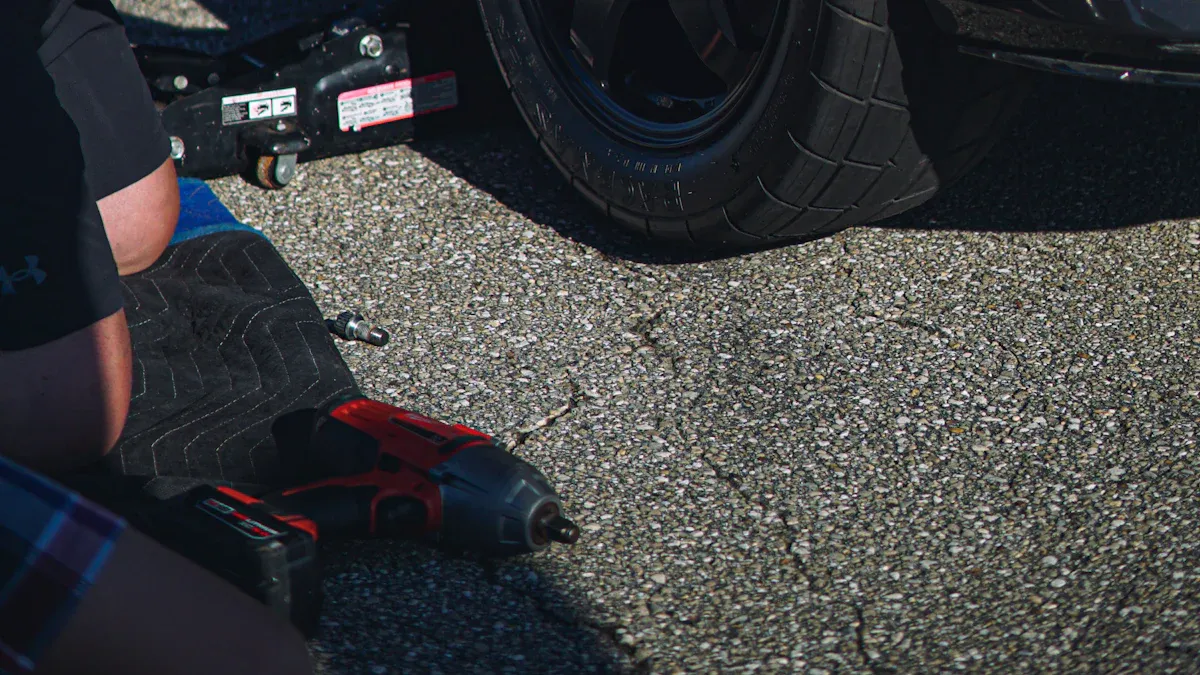When your tire gets a hole, you want a fix that keeps you safe. A tire patch is usually safer and lasts longer than a tire plug. This is true if you need the fix to last a long time. The best choice depends on where the hole is, how big it is, and how you drive. For example, a tire patch is good for bigger holes in the tread. Rubber tire plugs are fast for small and simple holes. Here are the main things to think about:
Factor | Tire Patch | Tire Plug |
|---|---|---|
Puncture Size & Location | Best for bigger holes in the tread | Best for small holes in the tread |
Repair Process | Tire must come off; takes more time | No need to take off tire; fast and easy |
Cost | Costs more because of extra work | Costs less; kits are cheap |
Durability & Longevity | Strong and lasts a long time | Not as strong; does not last as long |
Use Case | Good for long-term safety | Good for quick or short-term fixes |
Safety Considerations | Makes driving safer | May not fix all the damage |
You can feel sure this guide will help you choose the safest and cheapest way to fix your tire for how you drive.
Key Takeaways
Tire patches make a stronger fix. They seal the hole from inside the tire. This makes them safer for long-term use.
Tire plugs are a fast and easy fix for small holes. They do not last as long. They are best for emergencies or short trips.
Never fix holes in the tire sidewall. This kind of damage means you need a new tire to stay safe.
Professional repairs, like plug-patch combinations, are safest. They help your tire last longer and work better.
Check your tires often. Get expert help to pick the right repair. The best method depends on the hole size, where it is, and how you drive.
Plug vs Patch

Safety
When you think about plug vs patch, safety should come first. Tire patches give you a safer repair because they stick tightly to the inside of the tire. This strong seal helps prevent air leaks and keeps your tire working well. Tire plugs, on the other hand, only fill the hole from the outside. Over time, a tire plug can loosen and cause a flat tire while you drive. That can be dangerous, especially at high speeds.
Tip: Only use either method for holes in the middle of the tread. Never try to fix damage on the sidewall or shoulder of your tire. If the hole is bigger than 0.25 inches, you should replace the tire.
Automotive safety groups like the USTMA and TIA say that a plug-patch combination is the safest way to fix a tire. This method lets a technician check the inside of the tire and seal the hole from both sides. Most tire manufacturers do not accept a simple tire plug as a safe repair. They prefer a patch or a plug-patch combination for your safety.
Durability
Durability matters when you want your tire repair to last. Tire patches seal the hole from the inside and bond with the tire’s inner liner. This makes the repair strong and helps prevent leaks. A rubber tire plug is quicker to install, but it does not seal the inside of the tire. Because of this, tire plugs are more likely to fail over time.
Tire patches are considered a permanent fix if installed correctly. They can last for years, even up to the life of the tire. Tire plugs are best for small, simple holes and short-term use. If you want a long-lasting repair, choose a patch or a plug-patch combination.
Aspect | Tire Patch Repair | Tire Plug Repair |
|---|---|---|
Repair Method | Applied from inside, seals inner liner | Inserted from outside, fills hole |
Durability | Permanent if done right; lasts 7-10 years | Temporary; shorter lifespan |
Maintenance | Lower long-term costs | May need more repairs |
Best Use | Larger holes, risky tread areas | Small, simple punctures |
Cost
You might wonder about the cost difference in the plug vs patch debate. Both repairs can cost between $10 and $50 in the United States. Tire patching usually costs more because it takes more time and skill. The technician must remove the tire from the rim, clean the area, and apply the patch. This process gives you a higher-quality repair.
Tire plugging is faster and sometimes cheaper, especially if you use a DIY kit. Quick tire plugs can cost as little as $5, but professional plugging usually costs about the same as patching. Even though the price is similar, a tire patch gives you better value because it lasts longer and keeps your tire safer.
Repair Type | Typical Cost Range (USD) | Description and Notes |
|---|---|---|
Tire Patching | $10 – $50 | Permanent fix; involves removing tire, cleaning, applying patch, rebalancing; higher quality repair. |
Tire Plugging | $5 – $50 | Temporary fix; plug inserted without removing tire; cheaper but less durable; quick plugs cost $5-$10. |
Which Lasts Longer
If you want to know which lasts longer, you should look at how each repair works. Tire patches seal the hole from the inside and can last as long as the tire itself—often 7 to 10 years. Tire plugs, however, are a temporary fix. They may work for a while, but they can loosen or leak, especially if you drive a lot or hit bumps.
Most tire manufacturers and experts recommend a tire patch or a plug-patch combination for the longest-lasting repair. When you use these methods, your tire can last just as long as if it never had a hole. Tire plugs are best for emergencies or short trips, not for long-term use.
Note: Always have a professional check your tire after any repair. This helps make sure your vehicle stays safe and your tire lasts as long as possible.
Tire Patch
How It Works
A tire patch gives you a strong and lasting repair. You start by removing the wheel from your car. Next, you deflate the tire and take it off the rim. This step lets you see the inside of the tire and find the puncture. You mark the spot, pull out any sharp object, and clean the area. You use a rasp tool to roughen the surface so the patch sticks well. Then, you apply rubber cement and press the patch onto the inner liner. After a few minutes, you put the tire back on the rim, inflate it, and check for leaks. Finally, you rebalance the tire for a smooth ride.
Step-by-step process:
Remove the wheel from your vehicle.
Deflate the tire and take it off the rim.
Find and mark the puncture.
Remove any debris from the hole.
Roughen the area inside the tire.
Apply rubber cement and press on the patch.
Let the patch dry, then reinstall and inflate the tire.
Check for leaks and rebalance the tire.
Pros and Cons
Tire patches offer many benefits, but you should know the drawbacks too. Here is a quick look:
Advantages of Tire Patches | Disadvantages of Tire Patches |
|---|---|
Strong, permanent repair | More expensive than plugs |
Lasts 7 to 10 years if done right | Takes more time and effort |
Seals the inner liner, prevents leaks | Needs special tools and skills |
Keeps original tread depth | Can only patch a tire once |
A tire patch gives you a more reliable fix than a plug. It seals the inside of the tire and helps prevent future leaks.
When to Use
You should use a tire patch when you want a safe, long-term repair. Tire patches work best for punctures in the tread area, away from the sidewall. If the hole is small and not too close to the edge, a patch can last as long as the tire itself. Industry guidelines say you should not patch holes near the sidewall or larger than 1/4 inch. Always ask a professional if you are unsure. Tire patches are the right choice if you want to keep driving safely for many miles.
Tire Plug
How It Works
A tire plug gives you a fast way to fix a punctured tire when you need to get back on the road quickly. You do not need to remove the tire from your car in most cases. The process is simple and can be done with a basic repair kit. Here is how you use a tire plug:
Find the object that caused the puncture and pull it out.
Use a reaming tool to clean and widen the hole.
Thread the rubber plug through the insertion tool.
Push the tire plug into the hole until only a small part sticks out.
Pull the tool out, leaving the plug in place.
Trim any extra plug material flush with the tread.
Inflate the tire and check for leaks.
You can finish this repair in about 10 to 15 minutes. Some professional repairs, especially those that combine a plug and patch, may take up to 90 minutes.
Pros and Cons
Tire plugs offer both benefits and drawbacks. You should know these before you decide to use one.
Aspect | Benefits of Tire Plugs | Limitations of Tire Plugs |
|---|---|---|
Convenience | Easy to use, good for emergencies and DIY fixes | Not for large or sidewall punctures |
Cost | Cheap, quick solution | Not a permanent repair |
Functionality | Seals small holes in the tread | May leak if not installed right |
Safety | Lets you drive short distances at low speeds | Improper use can cause tire failure |
Professional Advice | Good to have a pro check the tire after using a plug | Industry does not recommend plugs as the only repair |
Note: Tire plugs work best for small holes in the tread. They do not fix damage near the sidewall or large punctures. Using a tire plug for these problems can lead to dangerous blowouts.
When to Use
You should use a tire plug when you have a small hole in the tread caused by a nail or screw. Tire plugs are perfect for emergencies or when you need a quick fix to get to a repair shop. Never use a tire plug for holes in the sidewall or for large punctures. The sidewall is important for the tire’s strength. Damage there can cause the tire to fail. If you see a large hole or sidewall damage, replace the tire instead of using a plug.
Tire plugs are best for:
Small, round holes in the tread
Temporary repairs until you can get professional help
Emergency situations when you need to drive a short distance
Always have a professional check your tire after using a tire plug. This helps keep you safe and makes sure your tire lasts as long as possible.
Professional Repair
DIY vs Professional
You might think fixing a tire at home saves time and money. For small punctures in the tread, a DIY tire repair can work if you have the right tools and feel confident. Many people use a plug kit for a quick flat tire repair when they are on the road. This method helps you get your vehicle moving again fast.
However, some situations need more than a simple fix. If your tire has a puncture near the sidewall, do not try to repair it yourself. The sidewall supports the tire’s shape and strength. Damage here can make the tire unsafe, even after a repair. Only a professional can check if the tire is safe to use or if you need a new one. Professionals use special tools and follow strict steps to make sure the tire repair lasts.
Here is a quick comparison:
Aspect | DIY Tire Repairs | Professional Tire Repairs |
|---|---|---|
Scope | Good for small punctures in the tread | Handles small and large damages, including sidewall tears |
Expertise | Needs skill and care | Done by trained technicians |
Durability | Often temporary | Long-lasting, often with a warranty |
Safety | Risk if done wrong | Safer, with full inspection and balancing |
Convenience | Fast and cheap for small fixes | May take longer and cost more |
Extra Services | None | Includes balancing, alignment, and full tire check |
Tip: Always let a professional check your tire after a DIY flat tire repair. This keeps you and your vehicle safe.
Manufacturer Advice
Tire manufacturers want you to stay safe on the road. They recommend using a patch and plug combination for most tire repair jobs. This method seals the hole from both inside and outside, keeping out water and dirt. The repair lasts longer and meets strict safety rules. Many top brands use this method for both radial and bias tires. These repairs work for holes up to 5/16 inch and even for angled punctures.
You should always use the right products and follow the instructions for a strong seal. Professional shops use special fluids and tools to make sure the tire repair holds up over time. This gives you peace of mind and helps your tire last as long as possible.
Sunsoul Tire Patch
Product Features
You can count on Sunsoul Tire Patch for fixing tires. Sunsoul is a top company in China. They make more than two million tire patches each month. This means you can always get their patches, no matter where you are. Sunsoul sells products in over 60 countries. Many drivers and shops trust their quality.
Sunsoul makes strong and dependable tire repair products. Their patches are thick and stick well. The round shape keeps the edges from peeling up. Each patch uses vulcanizing gum to make a tight seal and stop leaks. You can use Sunsoul patches on many tires, like bikes and trucks.
Sunsoul also has many tire repair tools and kits. Here are some of their products:
Feature | Description |
|---|---|
Product Type | Emergency tubeless tire repair seal insert plug tool |
Portability | Small size, comes with a nylon bag or case for easy carrying |
Functionality | Hand tool kit for quick repairs on car and truck tires |
Durability | Tested for quality, made with plastic and steel parts |
Warranty | 18 months |
Usage | Made for emergency tire repairs, easy and useful |
Fitment | Works for both car and truck tires |
You can also get manual, portable steel tire vulcanizing machines. These machines are made from strong steel and metal. They work on car and truck tires from 145 to 275mm wide. The machines keep the heat between 150-180°C for good repairs. Each machine has an 18-month warranty.
Service Advantages
Sunsoul works closely with dealers and repair shops. You get steady supply, good prices, and local help. Sunsoul gives training, shipping help, and support in many languages. You get fast answers and expert help.
Sunsoul gives full service from start to finish. Their team does research, makes new products, and helps after you buy. If you have a problem, Sunsoul fixes most issues in 72 hours. They have service centers around the world and offer lifetime help.
You can pick from many products. Sunsoul has chemical and dual cure patches, rubber solution, mounting paste, cushion gum, and sealants. This helps you fix any tire problem with confidence.
Sunsoul Tire Patch gives you good quality, trust, and help so you can drive safely anywhere.
Picking the right way to fix your tire helps keep you safe. Tire patches or plug-patch combos work best for most problems. You should always look at where the hole is. Think about how you drive your car. A trusted expert can help you choose a patch, plug, or new tire. Here is a simple checklist:
Repair Option | Best For | Not For |
|---|---|---|
Plug | Small tread punctures | Sidewall or large holes |
Patch | Long-term tread repairs | Angled or big punctures |
Plug-Patch Combo | Maximum safety and durability | High cost or quick fixes |
Check your tire every month or before long trips. Doing this and fixing tires the right way helps them last longer. It also keeps your car working well.
FAQ
Can you drive long distances with a tire plug?
You should not drive long distances with only a tire plug. Tire plugs work best for short trips or emergencies. For safe, long-term use, get your tire patched or use a plug-patch combo.
How do you know if a tire patch is holding?
Check your tire pressure often. If the pressure stays steady, the patch works. You can also listen for hissing sounds or use soapy water to spot bubbles at the repair site.
Is it safe to patch a tire more than once?
You should only patch a tire once in the same spot. Multiple patches can weaken the tire. If you see more than one hole close together, replace the tire for safety.
What happens if you plug a tire in the sidewall?
Never plug or patch a tire in the sidewall. The sidewall flexes a lot and cannot hold a repair. Driving on a sidewall repair can cause a blowout and put you in danger.





